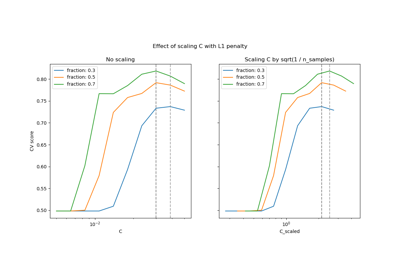validation_curve#
- sklearn.model_selection.validation_curve(estimator, X, y, *, param_name, param_range, groups=None, cv=None, scoring=None, n_jobs=None, pre_dispatch='all', verbose=0, error_score=nan, fit_params=None, params=None)[source]#
Validation curve.
Determine training and test scores for varying parameter values.
Compute scores for an estimator with different values of a specified parameter. This is similar to grid search with one parameter. However, this will also compute training scores and is merely a utility for plotting the results.
Read more in the User Guide.
- Parameters:
- estimatorobject type that implements the “fit” method
An object of that type which is cloned for each validation. It must also implement “predict” unless
scoringis a callable that doesn’t rely on “predict” to compute a score.- X{array-like, sparse matrix} of shape (n_samples, n_features)
Training vector, where
n_samplesis the number of samples andn_featuresis the number of features.- yarray-like of shape (n_samples,) or (n_samples, n_outputs) or None
Target relative to X for classification or regression; None for unsupervised learning.
- param_namestr
Name of the parameter that will be varied.
- param_rangearray-like of shape (n_values,)
The values of the parameter that will be evaluated.
- groupsarray-like of shape (n_samples,), default=None
Group labels for the samples used while splitting the dataset into train/test set. Only used in conjunction with a “Group” cv instance (e.g.,
GroupKFold).Changed in version 1.6:
groupscan only be passed if metadata routing is not enabled viasklearn.set_config(enable_metadata_routing=True). When routing is enabled, passgroupsalongside other metadata via theparamsargument instead. E.g.:validation_curve(..., params={'groups': groups}).- cvint, cross-validation generator or an iterable, default=None
Determines the cross-validation splitting strategy. Possible inputs for cv are:
None, to use the default 5-fold cross validation,
int, to specify the number of folds in a
(Stratified)KFold,An iterable yielding (train, test) splits as arrays of indices.
For int/None inputs, if the estimator is a classifier and
yis either binary or multiclass,StratifiedKFoldis used. In all other cases,KFoldis used. These splitters are instantiated withshuffle=Falseso the splits will be the same across calls.Refer User Guide for the various cross-validation strategies that can be used here.
Changed in version 0.22:
cvdefault value if None changed from 3-fold to 5-fold.- scoringstr or callable, default=None
Scoring method to use to evaluate the training and test sets.
str: see String name scorers for options.
callable: a scorer callable object (e.g., function) with signature
scorer(estimator, X, y). See Callable scorers for details.None: theestimator’s default evaluation criterion is used.
- n_jobsint, default=None
Number of jobs to run in parallel. Training the estimator and computing the score are parallelized over the combinations of each parameter value and each cross-validation split.
Nonemeans 1 unless in ajoblib.parallel_backendcontext.-1means using all processors. See Glossary for more details.- pre_dispatchint or str, default=’all’
Number of predispatched jobs for parallel execution (default is all). The option can reduce the allocated memory. The str can be an expression like ‘2*n_jobs’.
- verboseint, default=0
Controls the verbosity: the higher, the more messages.
- error_score‘raise’ or numeric, default=np.nan
Value to assign to the score if an error occurs in estimator fitting. If set to ‘raise’, the error is raised. If a numeric value is given, FitFailedWarning is raised.
Added in version 0.20.
- fit_paramsdict, default=None
Parameters to pass to the fit method of the estimator.
Deprecated since version 1.6: This parameter is deprecated and will be removed in version 1.8. Use
paramsinstead.- paramsdict, default=None
Parameters to pass to the estimator, scorer and cross-validation object.
If
enable_metadata_routing=False(default): Parameters directly passed to thefitmethod of the estimator.If
enable_metadata_routing=True: Parameters safely routed to thefitmethod of the estimator, to the scorer and to the cross-validation object. See Metadata Routing User Guide for more details.
Added in version 1.6.
- Returns:
- train_scoresarray of shape (n_ticks, n_cv_folds)
Scores on training sets.
- test_scoresarray of shape (n_ticks, n_cv_folds)
Scores on test set.
See also
ValidationCurveDisplay.from_estimatorPlot the validation curve given an estimator, the data, and the parameter to vary.
Notes
See Effect of model regularization on training and test error
Examples
>>> import numpy as np >>> from sklearn.datasets import make_classification >>> from sklearn.model_selection import validation_curve >>> from sklearn.linear_model import LogisticRegression >>> X, y = make_classification(n_samples=1_000, random_state=0) >>> logistic_regression = LogisticRegression() >>> param_name, param_range = "C", np.logspace(-8, 3, 10) >>> train_scores, test_scores = validation_curve( ... logistic_regression, X, y, param_name=param_name, param_range=param_range ... ) >>> print(f"The average train accuracy is {train_scores.mean():.2f}") The average train accuracy is 0.81 >>> print(f"The average test accuracy is {test_scores.mean():.2f}") The average test accuracy is 0.81

